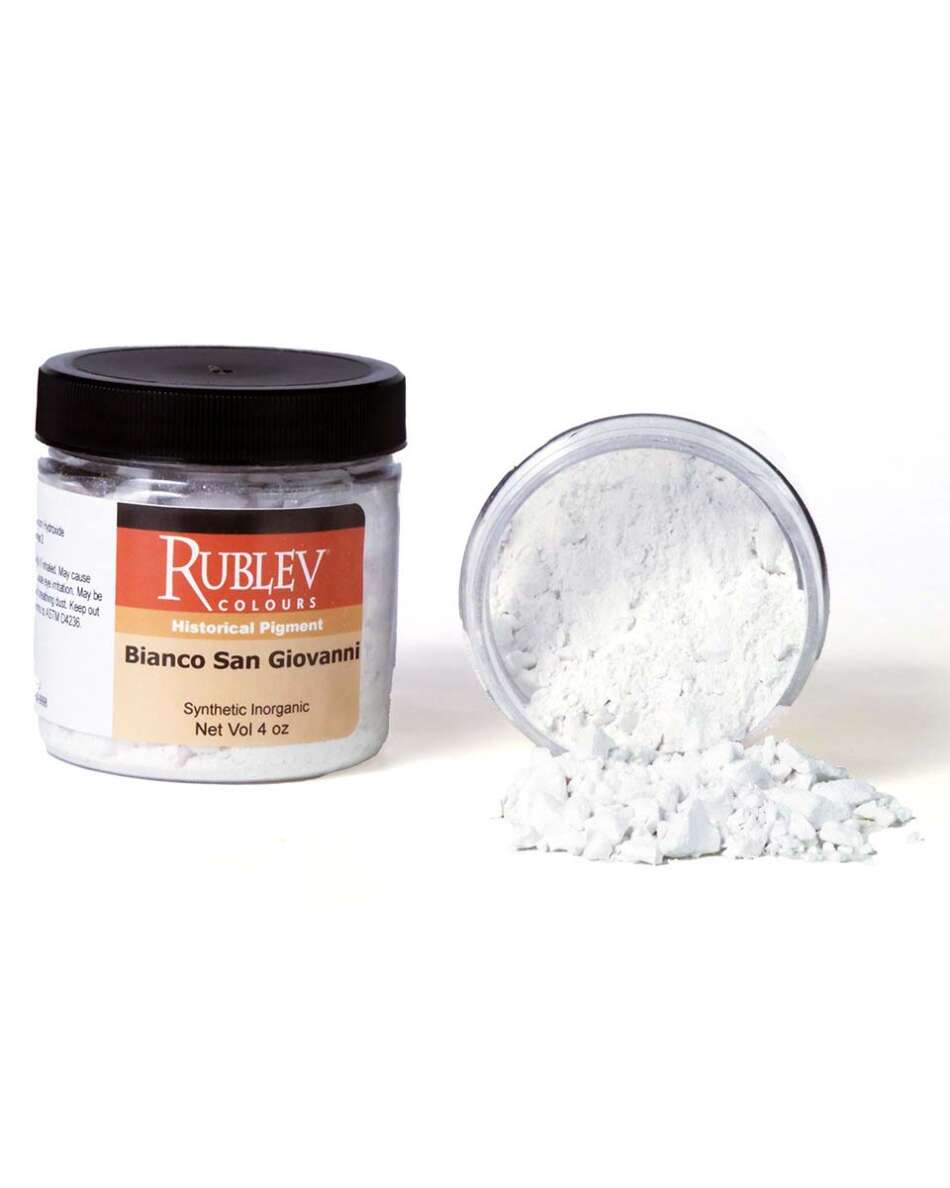Bianco di San Giovanni Pigment
Bianco di San Giovanni is lime white pigment first described in literature by Cennino Cennini. D. V. Thompson says the name comes from the patron saint of Florence.
Bianco di San Giovanni is a lime white pigment first described in the literature by Cennino Cennini. D. V. Thompson says the name comes from the patron saint of Florence.
| Pigment Names | |||||||
| Synonyms: | Lime white, Armenini’s white, Cennini’s white, Saint John’s white | ||||||
| Nomenclature: |
| ||||||
| Pigment Information | |
| Color: | White |
| Pigment Classification: | Synthetic Inorganic |
| Colour Index: | Not Listed |
| Chemical Name: | Calcium Hydroxide, Calcium Carbonate |
| Chemical Formula: | Ca(OH)2, CaCO3 |
| CAS No.: | 1305-62-0 (Calcium Hydroxide) |
| ASTM Lightfastness | |
| Acrylic: | Not Listed |
| Oil: | Not Listed |
| Watercolor: | Not Listed |
| Physical Properties | |
| Oil Absorption: | – |
| Particle Size (Average): | – |
| Density (at 20° C.): | 2.211 g/cm3 |
| Bulk Density: | – |
| Hardness: | 2.5 |
| Refractive Index: | 1.574 |
| pH: | 12.5 |
| Solubility: | 0.173 g/100 ml (20 °C) |
| Health and Safety | WARNING! Contains Calcium Hydroxide. Harmful if swallowed. It may cause burns. Avoid swallowing, contact with skin and eyes, and inhalation of dust. Keep out of reach of children. Conforms to ASTM D-4236. |
For a detailed explanation of the terms in the table above, please visit Composition and Permanence.
Origin and History
Cennino Cennini uses the name "Bianco di San Giovanni" to describe the preparation of a white lime pigment in his book Il Libro dell’Arte. He does not explain the name used for this lime white, and it is probable; therefore, this crucial white pigment was in use by artists before Cennini’s time. D. V. Thompson says it gets its name from the patron saint of Florence.
Source
Bianco di San Giovanni is a pigment of inorganic, natural mineral origin from limestone (calcium carbonate) deposits. Not to be confused with simple lime white or chalk, Bianco di San Giovanni, as Cennino Cennini reports, is dried lime which is reduced to powder and then immersed in the water for eight days that is changed each day. It is then made into small cakes and left to dry in the sun. It is then grounded finely.
Bianco di San Giovanni primarily consists of calcium hydroxide, also known as slaked lime, in a chemical compound with calcium carbonate. A traditional name for calcium hydroxide alone is slaked lime or hydrated lime. The name of the natural mineral is portlandite. A water suspension of fine calcium hydroxide particles is called “milk of lime.” When dissolved in water, the solution is called “lime water.” Bianco di San Giovanni is composed of slaked lime, and because it is dried in the sun, it absorbs carbon dioxide from the atmosphere and partially converts to calcium carbonate or lime.
Permanence and Compatibility
Bianco di San Giovanni is the white pigment par excellence for fresco painting. It is also used in tempera and grounds, while it is not advised in oil and encaustic painting techniques.
Oil Absorption and Grinding
Our lime white is coarsely ground. Lime white should be finely ground before use in fresco and casein tempera painting techniques.
Toxicity
Bianco di San Giovanni is not toxic; it is alkaline and may irritate the skin and eyes. Care should be used in handling the dry powder pigment to avoid inhaling the dust.
For more information on handling pigments safely, please visit How to Safely Handle Art Materials and Pigments.
| SKU | 475-41 |
|---|---|
| Brand | Rublev Colours |
| Vendor | Rublev Colours |
| Processing Time | Usually ships the next business day. |
| Color | White |
| Pigment Type | Inorganic, Historical, Synthetic |



